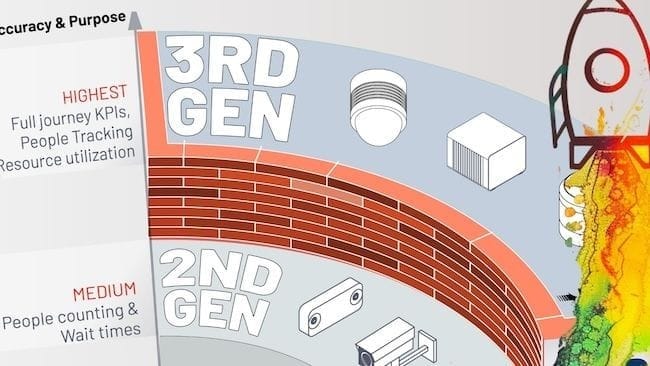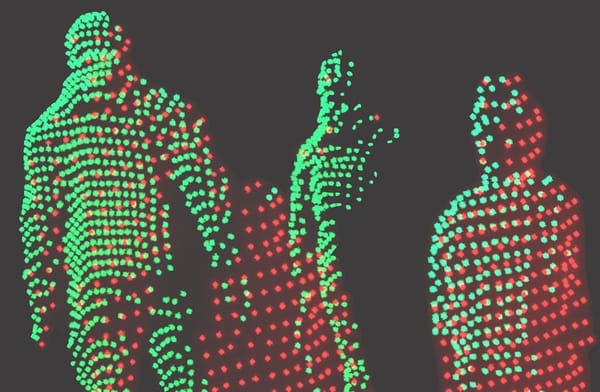
6 Key Benefits of LiDARs for Airports
LiDAR technology and Software is shaping a new wave of operational excellence, passenger experience and safety for airports of all sizes.
The ASQ 2023 Global Traveller Survey found that passengers have never been more eager to travel and almost 60% of them favour technological approaches to enhance their travel experience.
In the globally booming aviation industry, precision and efficiency are non-negotiable. Airports, the bustling hubs of travel, are constantly seeking innovative solutions to enhance their operations, elevate passenger experiences, and increase revenue from commercial activities.
LiDAR is a sophisticated remote sensing method that employs laser pulses to precisely measure distances to objects, providing intricate three-dimensional insights.

The third generation of people counting technology
After Wireless solutions (1st Generation) and Stereovision cameras from traditional companies like Xovis (2nd Generation), LiDAR technology brings a generational leap:


This new technology, when processed with the right LiDAR Software, provides many benefits for airports, that can be grouped in 6 categories:
1. Elevate Passenger Experiences
LiDAR technology revolutionizes airport management by providing actionable data for enhancing passenger flow management and real-time queue management.
Outsight's LiDAR-based Spatial Intelligence software can help airports to optimize passenger experiences, leading to higher airport ratings, increased time spent in retail areas, and reduced instances of missed flights.

2. Improve Operations and Forecast
LiDAR empowers airports to forecast future demands with precision. It enables airports to manage increased traffic without the need for additional resources through better allocation and optimal staffing.
Owing to real-time 3D data processing software like Outsight, airports can monitor actionable KPIs.

3. Higher Security and Safety
Remote sensing LiDAR technology provides real-time monitoring and accurate data insights. It helps airports minimize financial losses and reputational harm resulting from emergencies and false alarms.
With such 3D Computer Vision technology, airports can accurately manage risks such as unauthorized access and overcrowding, both indoors and outdoors, thereby safeguarding passengers and infrastructure.


4. Increase NAR (Non-Aeronautical Revenue)
An accurate understanding of shoppers' journeys through LiDAR insights enables airports to tailor retail offerings effectively and optimise airport layouts to ensure visibility to retailers.
By leveraging LiDAR technology to profile passenger behavior and extend their time in retail zones, airports can maximize non-aeronautical revenues.

Learn more about how NAR is becoming a key stream of revenue for major Airports
5. Accurate Infrastructure Planning
Remote sensing solutions facilitate strategic investments in airport infrastructure, resulting in improved space and resource utilization.
With extensive historical data for trend analysis and simulation tool made accessible by Outsight's solution, airports can make informed decisions regarding terminal layout and new construction projects.


6. Curbside and Parking Monitoring
Light Detection and Ranging enables comprehensive monitoring of mixed traffic, including vehicles and pedestrians, throughout airport premises.
By tracking the entire passenger journey from curbside to boarding gates, LiDAR provides valuable insights for optimizing operations and reducing congestion-related costs.

Get access to Outsight's Curbside Monitoring Whitepaper.
Conclusion
In summary, LiDARs when used with advanced software solutions like Outsight offer airports a host of advantages from improving passenger journeys to streamlining operations and fortifying safety protocols, monitoring queues in real-time, and planning infrastructure efficiently.
Furthermore, its role in boosting non-aeronautical revenue streams through tailored retail offerings and efficient space utilization underscores its significance in driving economic growth within airport ecosystems.
As airports continue to prioritize efficiency, safety, and customer satisfaction, integrating LiDAR technology into their operations emerges as a crucial step towards achieving operational excellence in the modern aviation landscape
Learn more
Explore why LiDAR is becoming the leading technology choice for Airports around the world.









